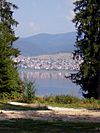Velingrad
You can help expand this article with text translated from the corresponding article in Bulgarian. (December 2008) Click [show] for important translation instructions.
|
Velingrad
Велинград | |
|---|---|
 Velingrad in mid-June 2008 | |
| Coordinates: 42°1′N 24°0′E / 42.017°N 24.000°E | |
| Country | Bulgaria |
| Province (Oblast) | Pazardzhik |
| Government | |
| • Mayor | Kostadin Koev |
| Area | |
| • Total | 124.955 km2 (48.245 sq mi) |
| Elevation | 777 m (2,549 ft) |
| Population (December 2011)[1] | |
| • Total | 22,500 |
| • Density | 180/km2 (470/sq mi) |
| Time zone | UTC+2 (EET) |
| • Summer (DST) | UTC+3 (EEST) |
| Postal Code | 4600 |
| Area code | 359 |
| Website | Official website |
Velingrad (Bulgarian: Велинград) is a town in Pazardzhik Province, Southern Bulgaria, located at the western end of Chepino Valley, part of the Rhodope Mountains. It is the administrative center of the homonymous Velingrad Municipality and one of the most popular Bulgarian balneological resorts. As of December 2009, the town has a population of 22,500 inhabitants.[1]
History

The region was inhabited by the Slavs. According to Bulgarian academics, the Dragovichi tribe lived there. The Dragovichi accepted many Thracian customs, but gave them typical Slavic characteristics. Soon after the Bulgar invasion of the Balkans, the whole region was annexed to the First Bulgarian Empire by Malamir.
Velingrad was founded in 1948 after the unification between the villages Chepino, Ladzhene and Kamenitsa. Chepino and Kamenitsa are older settlements, but Ladzhene was founded after 1878 by Bulgarian refugees from Macedonia, because their region remained under Ottoman rule after the Treaty of Berlin.
The town is named after Vela Peeva, a Bulgarian communist revolutionary who gave up her life during World War II.
Geography
Velingrad is situated at 750–850 m above sea level. Summers are warm and winters are cold. The average annual temperature is 10 °C, while the average July temperature is 19 °C. The annual duration of sunshine is about 2,000 hours. The relative air humidity ranges from 65 to 75%. Surrounded by age-old pine tree woods, the town favors abundant sunshine.
Waters
There are more than 90 mineral water springs with curative and preventive properties in and around the town. The mineral waters (from springs and wells) vary considerably in temperature, mineralization, radon, silicic acid and fluorine content, and are suitable for treatment of a wide range of diseases. 9000 litres of water per minute spring from the five thermal and mineral deposits in Ladzhene, Kamenitsa, Chepino, Rakitovo and Kostandovo.
Together with the numerous mineral waters, Velingrad boasts another natural phenomenon as well — the Kleptuza, the biggest Karst spring in Bulgaria, with an average discharge of 1200 litres of ice-cold water per second.
Culture, education and architecture
There are eight schools (five of them high schools),[2] three reference libraries (chitalishtes), about 100 hotels (some of which five-star), a stadium and a city orchestra.

The Villa Raîna is a Néo-Renaissance villa in the city's area of Ldžene (Bulgarian: Лъдженe) and was designed in 1928 by a renowned pre-WWII Serbian architect Milutin Borisavljević (1889-1970). Initially, "Raina" was conceived as the summer house of the Belgrade based industrialist, Stojadin "Stole" Stevović (1888-1945), for the needs of the families Stevović and Simić. The site selected was a hilltop just outside the city of Velingrad, locally called the "Acropolis". The design mainly reflected the values of French Renaissance architecture but with discreet decorative features in the then fashionable Art Deco style. The house was nationalized in 1946, and transformed into a sanatorium for the treatment of infectious diseases. In 1992 the Villa Raina was restituted to Stevović's heirs (families Krsmanović-Simić and Gillès de Pélichy). The summer house is today protected by law as a cultural and historical monument of regional importance.[3]
Honour
Velingrad Peninsula in Graham Land, Antarctica is named after the city.
Notes
- ^ a b (in English) Bulgarian National Statistical Institute - towns in 2011
- ^ (in Bulgarian) Register of schools, kindergartens and service sections [1]
- ^ Велинградски Темпо Новини - Вила “Райна”: от миналото се ражда бъдеще
External links




